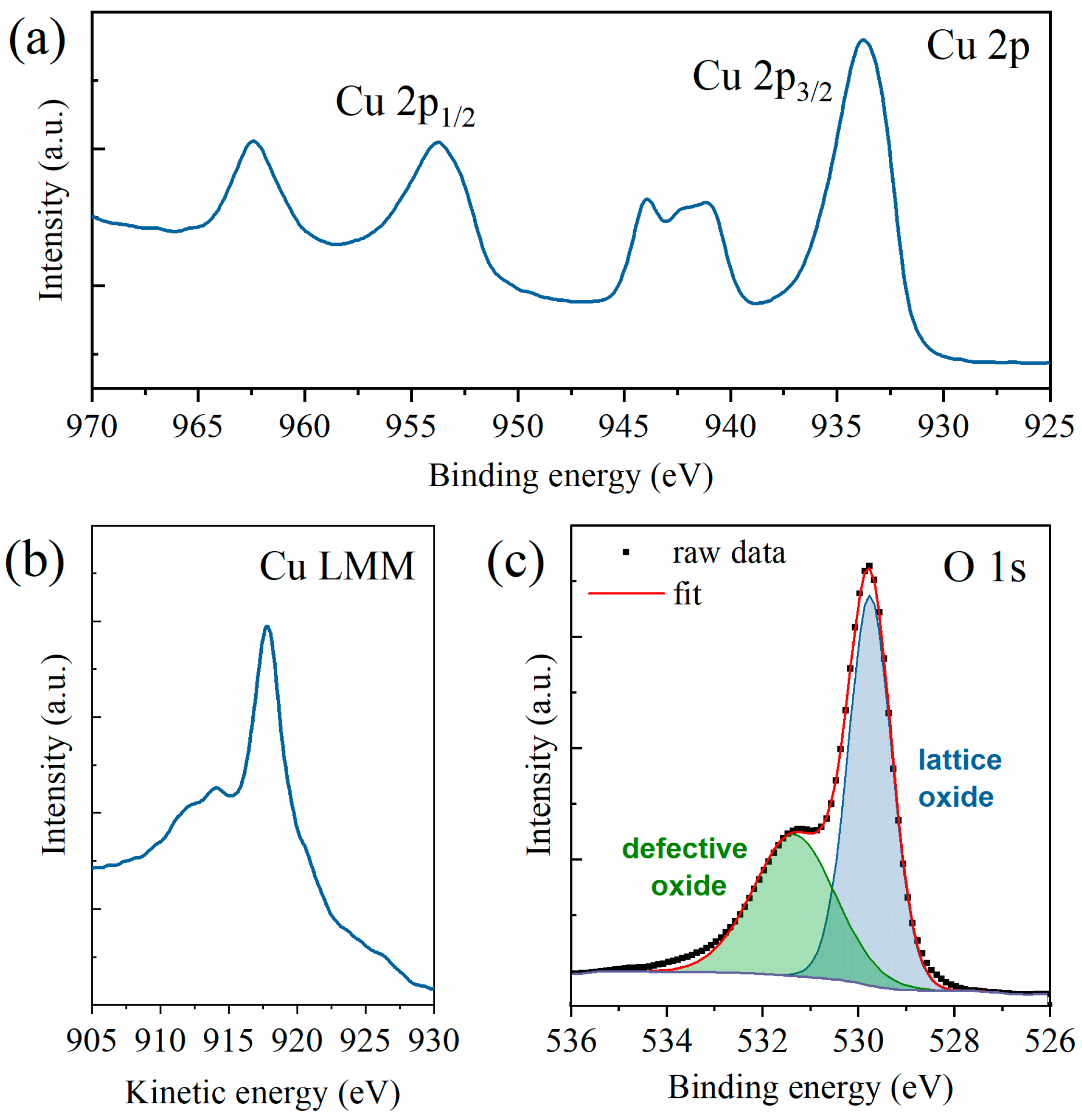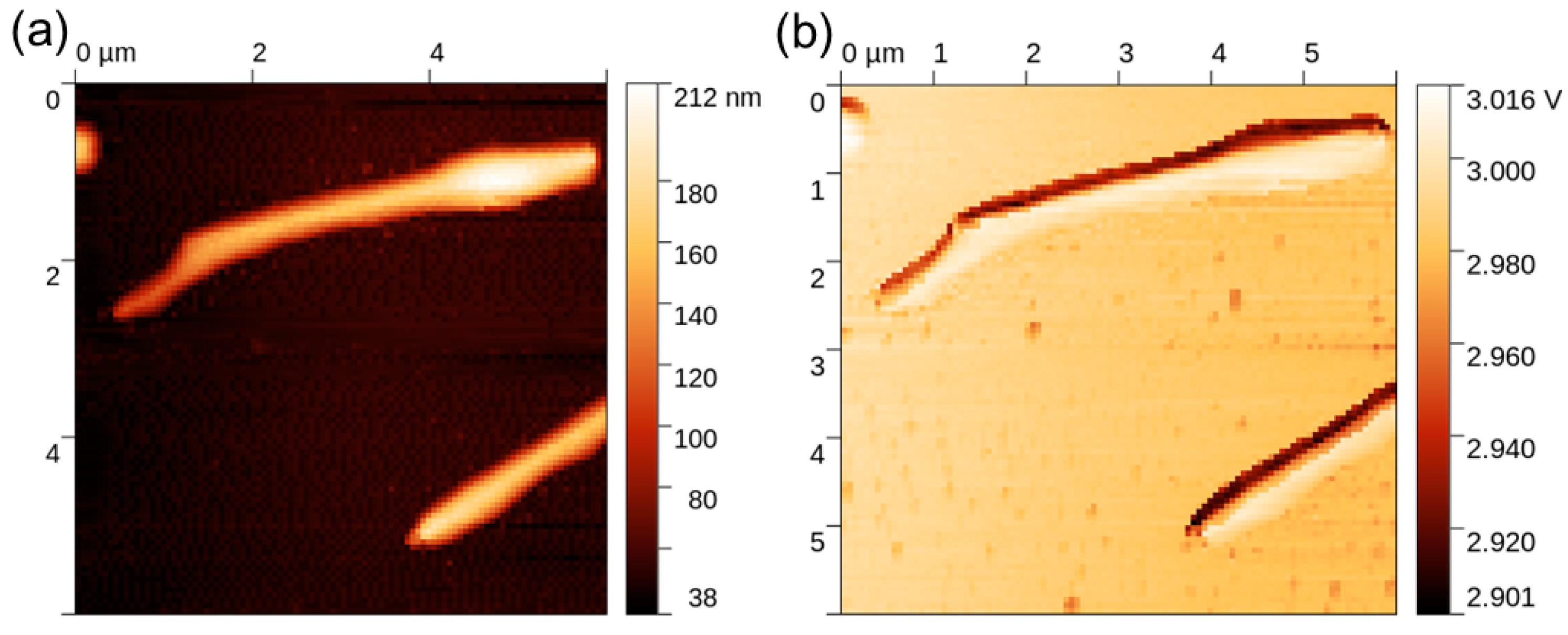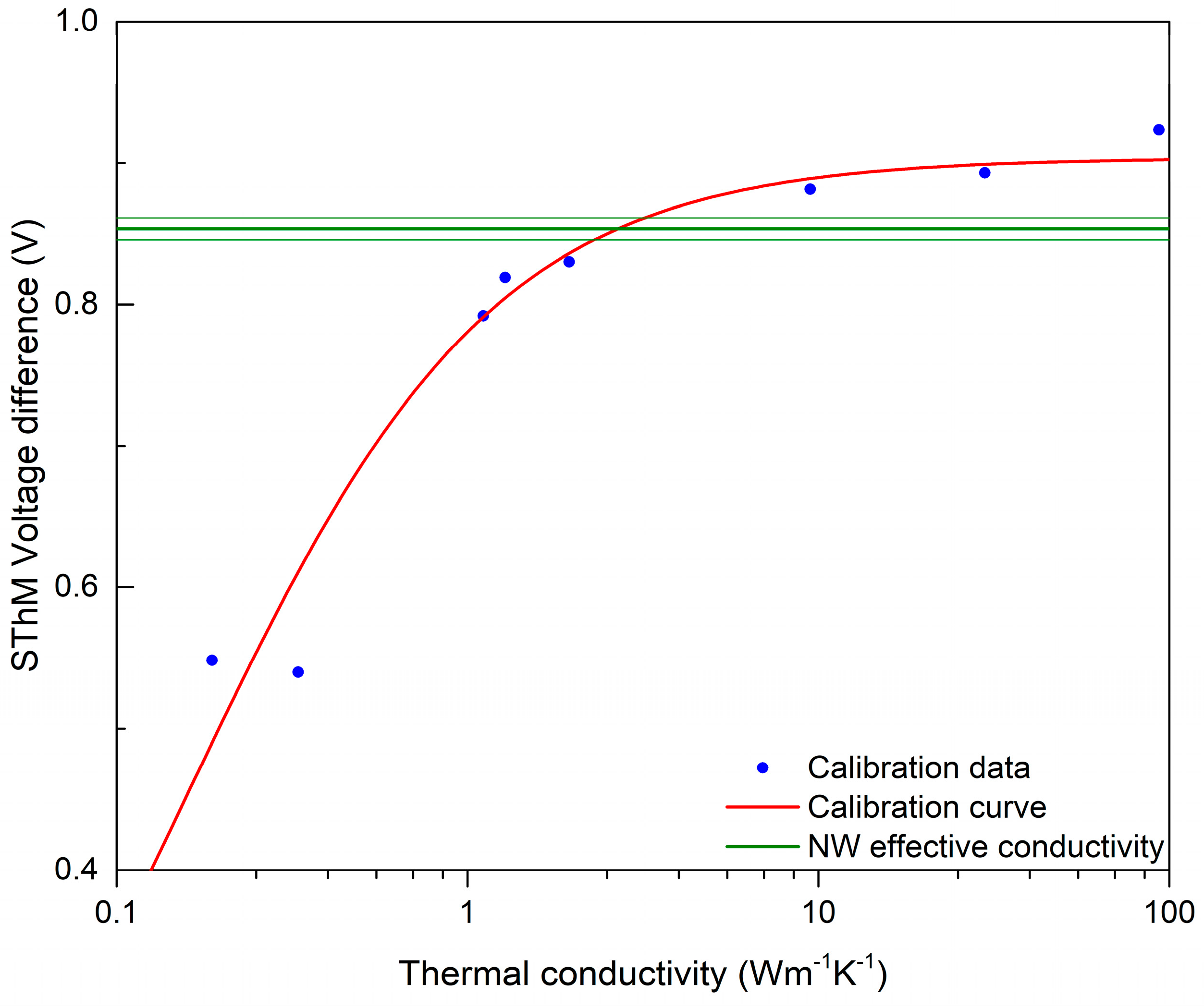Electrical and Thermal Conductivities of Single CuxO Nanowires
Abstract
:1. Introduction
2. Materials and Methods
2.1. Growth of CuxO NWs
2.2. Morphological, Structural, and Chemical Characterization
2.3. Single-NW-Based Device Fabrication
2.4. Electrical Characterization
2.5. Thermal Characterization
3. Results
3.1. Morphological Characterization
3.2. Structural Properties
3.3. Chemical Properties
3.4. Electrical Properties
3.5. Thermal Properties
4. Conclusions
Supplementary Materials
Author Contributions
Funding
Data Availability Statement
Acknowledgments
Conflicts of Interest
References
- Lu, W.; Lieber, C.M. Semiconductor Nanowires. J. Phys. D Appl. Phys. 2006, 39, R387–R406. [Google Scholar] [CrossRef]
- Law, M.; Goldberger, J.; Yang, P. Semiconductor nanowires and nanotubes. Annu. Rev. Mater. Res. 2004, 34, 83–122. [Google Scholar] [CrossRef]
- Goldberger, J.; Hochbaum, A.I.; Fan, R.; Yang, P. Silicon Vertically Integrated Nanowire Field Effect Transistors. Nano Lett. 2006, 6, 973–977. [Google Scholar] [CrossRef]
- Thelander, C.; Agarwal, P.; Brongersma, S.; Eymery, J.; Feiner, L.F.; Forchel, A.; Scheffler, M.; Riess, W.; Ohlsson, B.J.; Gösele, U.; et al. Nanowire-Based One-Dimensional Electronics. Mater. Today 2006, 9, 28–35. [Google Scholar] [CrossRef]
- Xiang, J.; Lu, W.; Hu, Y.; Wu, Y.; Yan, H.; Lieber, C.M. Ge/Si Nanowire Heterostructures as High-Performance Field-Effect Transistors. Nature 2006, 441, 489–493. [Google Scholar] [CrossRef] [PubMed]
- LaPierre, R.R.; Chia, A.C.E.; Gibson, S.J.; Haapamaki, C.M.; Boulanger, J.; Yee, R.; Kuyanov, P.; Zhang, J.; Tajik, N.; Jewell, N.; et al. III–V Nanowire Photovoltaics: Review of Design for High Efficiency. Phys. Status Solidi (RRL) Rapid Res. Lett. 2013, 7, 815–830. [Google Scholar] [CrossRef]
- Dasgupta, N.P.; Yang, P. Semiconductor Nanowires for Photovoltaic and Photoelectrochemical Energy Conversion. Front. Phys. 2014, 9, 289–302. [Google Scholar] [CrossRef]
- Hochbaum, A.I.; Yang, P. Semiconductor Nanowires for Energy Conversion. Chem. Rev. 2010, 110, 527–546. [Google Scholar] [CrossRef] [PubMed]
- Nehra, M.; Dilbaghi, N.; Marrazza, G.; Kaushik, A.; Abolhassani, R.; Mishra, Y.K.; Kim, K.H.; Kumar, S. 1D Semiconductor Nanowires for Energy Conversion, Harvesting and Storage Applications. Nano Energy 2020, 76, 104991. [Google Scholar] [CrossRef]
- Li, Z.; Sun, Q.; Yao, X.D.; Zhu, Z.H.; Lu, G.Q.M. Semiconductor Nanowires for Thermoelectrics. J. Mater. Chem. 2012, 22, 22821. [Google Scholar] [CrossRef]
- Xiang, L.; Guo, J.; Wu, C.; Cai, M.; Zhou, X.; Zhang, N. A Brief Review on the Growth Mechanism of CuO Nanowires via Thermal Oxidation. J. Mater. Res. 2018, 33, 2264–2280. [Google Scholar] [CrossRef]
- Othonos, A.; Zervos, M. Ultrafast Hole Carrier Relaxation Dynamics in P-Type CuO Nanowires. Nanoscale Res. Lett. 2011, 6, 622. [Google Scholar] [CrossRef]
- Ching, W.Y.; Xu, Y.-N.; Wong, K.W. Ground-state and optical properties of Cu2O and CuO crystals. Phys. Rev. B 1989, 40, 7684–7695. [Google Scholar] [CrossRef]
- Musa, A.O.; Akomolafe, T.; Carter, M.J. Production of Cuprous Oxide, a Solar Cell Material, by Thermal Oxidation and a Study of Its Physical and Electrical Properties. Sol. Energy Mater. Sol. Cells 1998, 51, 305–316. [Google Scholar] [CrossRef]
- Košiček, M.; Zavašnik, J.; Baranov, O.; Šetina Batič, B.; Cvelbar, U. Understanding the Growth of Copper Oxide Nanowires and Layers by Thermal Oxidation over a Broad Temperature Range at Atmospheric Pressure. Cryst. Growth Des. 2022, 22, 6656–6666. [Google Scholar] [CrossRef]
- Kim, Y.-S.; Hwang, I.-S.; Kim, S.-J.; Lee, C.-Y.; Lee, J.-H. CuO Nanowire Gas Sensors for Air Quality Control in Automotive Cabin. Sens. Actuators B Chem. 2008, 135, 298–303. [Google Scholar] [CrossRef]
- Luo, L.-B.; Wang, X.-H.; Xie, C.; Li, Z.-J.; Lu, R.; Yang, X.-B.; Lu, J. One-Dimensional CuO Nanowire: Synthesis, Electrical, and Optoelectronic Devices Application. Nanoscale Res. Lett. 2014, 9, 637. [Google Scholar] [CrossRef] [PubMed]
- Li, D.; Hu, J.; Wu, R.; Lu, J.G. Conductometric Chemical Sensor Based on Individual CuO Nanowires. Nanotechnology 2010, 21, 485502. [Google Scholar] [CrossRef] [PubMed]
- Moise, C.C.; Enache, L.-B.; Anăstăsoaie, V.; Lazăr, O.A.; Mihai, G.V.; Bercu, M.; Enăchescu, M. On the Growth of Copper Oxide Nanowires by Thermal Oxidation near the Threshold Temperature at Atmospheric Pressure. J. Alloys Compd. 2021, 886, 161130. [Google Scholar] [CrossRef]
- Zhu, Y.W.; Yu, T.; Cheong, F.C.; Xu, X.J.; Lim, C.T.; Tan, V.B.C.; Thong, J.T.L.; Sow, C.H. Large-Scale Synthesis and Field Emission Properties of Vertically Oriented CuO Nanowire Films. Nanotechnology 2005, 16, 88–92. [Google Scholar] [CrossRef]
- Gonçalves, A.M.B.; Campos, L.C.; Ferlauto, A.S.; Lacerda, R.G. On the Growth and Electrical Characterization of CuO Nanowires by Thermal Oxidation. J. Appl. Phys. 2009, 106, 034303. [Google Scholar] [CrossRef]
- Hansen, B.J.; Kouklin, N.; Lu, G.; Lin, I.-K.; Chen, J.; Zhang, X. Transport, Analyte Detection, and Opto-Electronic Response of p-Type CuO Nanowires. J. Phys. Chem. C 2010, 114, 2440–2447. [Google Scholar] [CrossRef]
- Volanti, D.P.; Felix, A.A.; Suman, P.H.; Longo, E.; Varela, J.A.; Orlandi, M.O. Monitoring a CuO Gas Sensor at Work: An Advanced in Situ X-Ray Absorption Spectroscopy Study. Phys. Chem. Chem. Phys. 2015, 17, 18761–18767. [Google Scholar] [CrossRef] [PubMed]
- Steinhauer, S.; Köck, A.; Gspan, C.; Grogger, W.; Vandamme, L.K.J.; Pogany, D. Low-Frequency Noise Characterization of Single CuO Nanowire Gas Sensor Devices. Appl. Phys. Lett. 2015, 107, 123112. [Google Scholar] [CrossRef]
- Zappa, D.; Comini, E.; Sberveglieri, G. Thermally Oxidized Zinc Oxide Nanowires for Use as Chemical Sensors. Nanotechnology 2013, 24, 444008. [Google Scholar] [CrossRef]
- Raveesh, S.; Yadav, V.K.S.; Daniel, T.T.; Paily, R. CuO Single-Nanowire Printed Devices for Volatile Organic Compounds (VOCs) Detection. IEEE Trans. Nanotechnol. 2023, 22, 387–392. [Google Scholar] [CrossRef]
- Lamberti, A.; Destro, M.; Bianco, S.; Quaglio, M.; Chiodoni, A.; Pirri, C.F.; Gerbaldi, C. Facile Fabrication of Cuprous Oxide Nanocomposite Anode Films for Flexible Li-Ion Batteries via Thermal Oxidation. Electrochim. Acta 2012, 86, 323–329. [Google Scholar] [CrossRef]
- Lamberti, A.; Fontana, M.; Bianco, S.; Tresso, E. Flexible Solid-State CuxO-Based Pseudo-Supercapacitor by Thermal Oxidation of Copper Foils. Int. J. Hydrogen Energy 2016, 41, 11700–11708. [Google Scholar] [CrossRef]
- Fan, Z.; Fan, X.; Li, A.; Dong, L. In Situ Forming, Characterization, and Transduction of Nanowire Memristors. Nanoscale 2013, 5, 12310. [Google Scholar] [CrossRef]
- Liu, J.-N.; Chen, F.-X.; Deng, W.; Yu, X.-L.; Wang, L.-S. Optically-Controlled Resistive Switching Effects of CdS Nanowire Memtransistor. Chin. Phys. B 2021, 30, 116105. [Google Scholar] [CrossRef]
- Park, K.; Lee, J.-S. Controlled Synthesis of Ni/CuOx/Ni Nanowires by Electrochemical Deposition with Self-Compliance Bipolar Resistive Switching. Sci. Rep. 2016, 6, 23069. [Google Scholar] [CrossRef] [PubMed]
- Wang, S.B.; Hsiao, C.H.; Chang, S.J.; Lam, K.T.; Wen, K.H.; Hung, S.C.; Young, S.J.; Huang, B.R. A CuO Nanowire Infrared Photodetector. Sens. Actuators A Phys. 2011, 171, 207–211. [Google Scholar] [CrossRef]
- Jo, M.-S.; Song, H.-J.; Kim, B.-J.; Shin, Y.-K.; Kim, S.-H.; Tian, X.; Kim, S.-M.; Seo, M.-H.; Yoon, J.-B. Aligned CuO Nanowire Array for a High Performance Visible Light Photodetector. Sci. Rep. 2022, 12, 2284. [Google Scholar] [CrossRef]
- Scuderi, V.; Amiard, G.; Boninelli, S.; Scalese, S.; Miritello, M.; Sberna, P.M.; Impellizzeri, G.; Privitera, V. Photocatalytic Activity of CuO and Cu2O Nanowires. Mater. Sci. Semicond. Process. 2016, 42, 89–93. [Google Scholar] [CrossRef]
- Qin, S.; Liu, Y.; Liu, S.; Wang, X.; Li, Y.; Qin, C.; Wang, Z.; Li, M. Self-Standing Porous Au/CuO Nanowires with Remarkably Enhanced Visible Light Absorption and Photocatalytic Performance. Appl. Surf. Sci. 2022, 594, 153443. [Google Scholar] [CrossRef]
- Liu, X.; Li, Z.; Zhao, C.; Zhao, W.; Yang, J.; Wang, Y.; Li, F. Facile Synthesis of Core–Shell CuO/Ag Nanowires with Enhanced Photocatalytic and Enhancement in Photocurrent. J. Colloid Interface Sci. 2014, 419, 9–16. [Google Scholar] [CrossRef] [PubMed]
- Wang, P.; Zhao, X.; Li, B. ZnO-Coated CuO Nanowire Arrays: Fabrications, Optoelectronic Properties, and Photovoltaic Applications. Opt. Express 2011, 19, 11271. [Google Scholar] [CrossRef]
- Jun, J.; Jin, C.; Kim, H.; Park, S.; Lee, C. Fabrication and Characterization of CuO-Core/TiO2-Shell One-Dimensional Nanostructures. Appl. Surf. Sci. 2009, 255, 8544–8550. [Google Scholar] [CrossRef]
- Milano, G.; D’Ortenzi, L.; Bejtka, K.; Ciubini, B.; Porro, S.; Boarino, L.; Ricciardi, C. Metal–Insulator Transition in Single Crystalline ZnO Nanowires. Nanotechnology 2021, 32, 185202. [Google Scholar] [CrossRef]
- Milano, G.; Boarino, L.; Valov, I.; Ricciardi, C. Memristive Devices Based on Single ZnO Nanowires—From Material Synthesis to Neuromorphic Functionalities. Semicond. Sci. Technol. 2022, 37, 034002. [Google Scholar] [CrossRef]
- D’Ortenzi, L.; Monsù, R.; Cara, E.; Fretto, M.; Kara, S.; Rezvani, S.J.; Boarino, L. Electrical Contacts on Silicon Nanowires Produced by Metal-Assisted Etching: A Comparative Approach. Nanoscale Res. Lett. 2016, 11, 468. [Google Scholar] [CrossRef] [PubMed]
- Guen, E.; Chapuis, P.-O.; Rajkumar, R.; Dobson, P.S.; Mills, G.; Weaver, J.M.R.; Gomés, S. Scanning Thermal Microscopy on Samples of Varying Effective Thermal Conductivities and Identical Flat Surfaces. J. Appl. Phys. 2020, 128, 235301. [Google Scholar] [CrossRef]
- Nečas, D.; Klapetek, P. Gwyddion: An Open-Source Software for SPM Data Analysis. Open Phys. 2012, 10, 181–188. [Google Scholar] [CrossRef]
- Huang, L.S.; Yang, S.G.; Li, T.; Gu, B.X.; Du, Y.W.; Lu, Y.N.; Shi, S.Z. Preparation of Large-Scale Cupric Oxide Nanowires by Thermal Evaporation Method. J. Cryst. Growth 2004, 260, 130–135. [Google Scholar] [CrossRef]
- Tran, T.H.; Nguyen, M.H.; Nguyen, T.H.T.; Dao, V.P.T.; Nguyen, P.M.; Nguyen, V.T.; Pham, N.H.; Le, V.V.; Sai, C.D.; Nguyen, Q.H.; et al. Effect of Annealing Temperature on Morphology and Structure of CuO Nanowires Grown by Thermal Oxidation Method. J. Cryst. Growth 2019, 505, 33–37. [Google Scholar] [CrossRef]
- Lee, S.-K.; Tuan, W.-H. Scalable Process to Produce CuO Nanowires and Their Formation Mechanism. Mater. Lett. 2014, 117, 101–103. [Google Scholar] [CrossRef]
- Yuan, L.; Wang, Y.; Mema, R.; Zhou, G. Driving Force and Growth Mechanism for Spontaneous Oxide Nanowire Formation during the Thermal Oxidation of Metals. Acta Mater. 2011, 59, 2491–2500. [Google Scholar] [CrossRef]
- Mema, R.; Yuan, L.; Du, Q.; Wang, Y.; Zhou, G. Effect of Surface Stresses on CuO Nanowire Growth in the Thermal Oxidation of Copper. Chem. Phys. Lett. 2011, 512, 87–91. [Google Scholar] [CrossRef]
- Filipič, G.; Cvelbar, U. Copper Oxide Nanowires: A Review of Growth. Nanotechnology 2012, 23, 194001. [Google Scholar] [CrossRef]
- Wu, F.; Myung, Y.; Banerjee, P. Unravelling Transient Phases during Thermal Oxidation of Copper for Dense CuO Nanowire Growth. CrystEngComm 2014, 16, 3264–3267. [Google Scholar] [CrossRef]
- Chusuei, C.C.; Brookshier, M.A.; Goodman, D.W. Correlation of Relative X-Ray Photoelectron Spectroscopy Shake-up Intensity with CuO Particle Size. Langmuir 1999, 15, 2806–2808. [Google Scholar] [CrossRef]
- Yin, M.; Wu, C.-K.; Lou, Y.; Burda, C.; Koberstein, J.T.; Zhu, Y.; O’Brien, S. Copper Oxide Nanocrystals. J. Am. Chem. Soc. 2005, 127, 9506–9511. [Google Scholar] [CrossRef] [PubMed]
- Biesinger, M.C. Advanced Analysis of Copper X-Ray Photoelectron Spectra. Surf. Interface Anal. 2017, 49, 1325–1334. [Google Scholar] [CrossRef]
- Biesinger, M.C.; Lau, L.W.M.; Gerson, A.R.; Smart, R.S.C. Resolving Surface Chemical States in XPS Analysis of First Row Transition Metals, Oxides and Hydroxides: Sc, Ti, V, Cu and Zn. Appl. Surf. Sci. 2010, 257, 887–898. [Google Scholar] [CrossRef]
- Svintsitskiy, D.A.; Stadnichenko, A.I.; Demidov, D.V.; Koscheev, S.V.; Boronin, A.I. Investigation of Oxygen States and Reactivities on a Nanostructured Cupric Oxide Surface. Appl. Surf. Sci. 2011, 257, 8542–8549. [Google Scholar] [CrossRef]
- Chen, J.T.; Zhang, F.; Wang, J.; Zhang, G.A.; Miao, B.B.; Fan, X.Y.; Yan, D.; Yan, P.X. CuO Nanowires Synthesized by Thermal Oxidation Route. J. Alloys Compd. 2008, 454, 268–273. [Google Scholar] [CrossRef]
- Xu, C.H.; Woo, C.H.; Shi, S.Q. Formation of CuO Nanowires on Cu Foil. Chem. Phys. Lett. 2004, 399, 62–66. [Google Scholar] [CrossRef]
- Miranda, E.; Milano, G.; Ricciardi, C. Compact Modeling of the I-V Characteristics of ZnO Nanowires Including Nonlinear Series Resistance Effects. IEEE Trans. Nanotechnol. 2020, 19, 297–300. [Google Scholar] [CrossRef]
- Milano, G.; Boarino, L.; Ricciardi, C. Junction Properties of Single ZnO Nanowires with Asymmetrical Pt and Cu Contacts. Nanotechnology 2019, 30, 244001. [Google Scholar] [CrossRef]
- Léonard, F.; Talin, A.A. Electrical Contacts to One- and Two-Dimensional Nanomaterials. Nat. Nanotechnol. 2011, 6, 773–783. [Google Scholar] [CrossRef]
- Florica, C.; Costas, A.; Boni, A.G.; Negrea, R.; Ion, L.; Preda, N.; Pintilie, L.; Enculescu, I. Electrical Properties of Single CuO Nanowires for Device Fabrication: Diodes and Field Effect Transistors. Appl. Phys. Lett. 2015, 106, 223501. [Google Scholar] [CrossRef]
- Chiquito, A.J.; Amorim, C.A.; Berengue, O.M.; Araujo, L.S.; Bernardo, E.P.; Leite, E.R. Back-to-Back Schottky Diodes: The Generalization of the Diode Theory in Analysis and Extraction of Electrical Parameters of Nanodevices. J. Phys. Condens. Matter 2012, 24, 225303. [Google Scholar] [CrossRef] [PubMed]
- Kim, J.-H.; Katoch, A.; Choi, S.-W.; Kim, S.S. Growth and Sensing Properties of Networked P-CuO Nanowires. Sens. Actuators B Chem. 2015, 212, 190–195. [Google Scholar] [CrossRef]
- Zhang, Q.; Zhang, K.; Xu, D.; Yang, G.; Huang, H.; Nie, F.; Liu, C.; Yang, S. CuO Nanostructures: Synthesis, Characterization, Growth Mechanisms, Fundamental Properties, and Applications. Prog. Mater. Sci. 2014, 60, 208–337. [Google Scholar] [CrossRef]
- Kulkarni, S.; Ghosh, R. A Simple Approach for Sensing and Accurate Prediction of Multiple Organic Vapors by Sensors Based on CuO Nanowires. Sens. Actuators B Chem. 2021, 335, 129701. [Google Scholar] [CrossRef]
- Ramgir, N.S.; Ganapathi, S.K.; Kaur, M.; Datta, N.; Muthe, K.P.; Aswal, D.K.; Gupta, S.K.; Yakhmi, J.V. Sub-Ppm H2S Sensing at Room Temperature Using CuO Thin Films. Sens. Actuators B Chem. 2010, 151, 90–96. [Google Scholar] [CrossRef]
- Mirzaei, A.; Leonardi, S.G.; Neri, G. Detection of Hazardous Volatile Organic Compounds (VOCs) by Metal Oxide Nanostructures-Based Gas Sensors: A Review. Ceram. Int. 2016, 42, 15119–15141. [Google Scholar] [CrossRef]
- Ji, H.; Zeng, W.; Li, Y. Gas Sensing Mechanisms of Metal Oxide Semiconductors: A Focus Review. Nanoscale 2019, 11, 22664–22684. [Google Scholar] [CrossRef]
- Nayak, A.K.; Ghosh, R.; Santra, S.; Guha, P.K.; Pradhan, D. Hierarchical Nanostructured WO 3 –SnO 2 for Selective Sensing of Volatile Organic Compounds. Nanoscale 2015, 7, 12460–12473. [Google Scholar] [CrossRef]
- Zhao, Y.; Xiao, X.; Huo, Y.; Wang, Y.; Zhang, T.; Jiang, K.; Wang, J.; Fan, S.; Li, Q. Influence of Asymmetric Contact Form on Contact Resistance and Schottky Barrier, and Corresponding Applications of Diode. ACS Appl. Mater. Interfaces 2017, 9, 18945–18955. [Google Scholar] [CrossRef]
- Cao, Q.; Han, S.-J.; Tulevski, G.S.; Franklin, A.D.; Haensch, W. Evaluation of Field-Effect Mobility and Contact Resistance of Transistors That Use Solution-Processed Single-Walled Carbon Nanotubes. ACS Nano 2012, 6, 6471–6477. [Google Scholar] [CrossRef] [PubMed]
- Wu, J.; Yin, B.; Wu, F.; Myung, Y.; Banerjee, P. Charge Transport in Single CuO Nanowires. Appl. Phys. Lett. 2014, 105, 183506. [Google Scholar] [CrossRef]
- Sondors, R.; Kosmaca, J.; Kunakova, G.; Jasulaneca, L.; Ramma, M.M.; Meija, R.; Kauranens, E.; Antsov, M.; Erts, D. Size Distribution, Mechanical and Electrical Properties of CuO Nanowires Grown by Modified Thermal Oxidation Methods. Nanomaterials 2020, 10, 1051. [Google Scholar] [CrossRef] [PubMed]
- Klapetek, P.; Martinek, J.; Grolich, P.; Valtr, M.; Kaur, N.J. Graphics Cards Based Topography Artefacts Simulations in Scanning Thermal Microscopy. Int. J. Heat Mass. Transf. 2017, 108, 841–850. [Google Scholar] [CrossRef]






| Ref | Wiring Metal | NW Size (Diameter, Length) | Electrode Configuration | σ @ 300 K (Air/Vacuum) |
|---|---|---|---|---|
| This work | Cu (50 nm) | 64 nm, 640 nm | 2T and 4T I–Vs | 7.6 × 10−2 S∙cm−1 (vacuum) |
| [21] | Cr/Au (10/100 nm) | 250 nm, 15 μm | 2T I–V | 2.5 × 10−4 S∙cm−1 (NA) |
| [72] | Au by dielectrophoresis | 85 nm, 2.25 μm | 2T I–V, space charge limited current model | ~1 × 10−2 S∙cm−1 (vacuum) |
| [61] | Pt (300 nm) by IBID, Ti/Au (100/300 nm) | ~60 nm, NA | 2T I–V back-to-back Schottky, 4T I–V | ~5.5 × 10−3 S∙cm−1 ~8.5 × 10−3 S∙cm−1 (vacuum) |
| [24] | Ni/Au (10/190 nm) | 143 nm, 1.9 μm | 2T and 4T I–Vs | ~4 × 10−3 S∙cm−1 (air) |
| [73] | Pd/Au (3/80 nm) | 36–50 nm, 80 nm–2 μm | 2T I–V | ~1–0.25 × 10−3 S∙cm−1 (air) |
| [18] | Ti/Au (5/50 nm) | ~80 nm, NA | 2T I–V | 1.1 × 10−3 S∙cm−1 (air) |
Disclaimer/Publisher’s Note: The statements, opinions and data contained in all publications are solely those of the individual author(s) and contributor(s) and not of MDPI and/or the editor(s). MDPI and/or the editor(s) disclaim responsibility for any injury to people or property resulting from any ideas, methods, instructions or products referred to in the content. |
© 2023 by the authors. Licensee MDPI, Basel, Switzerland. This article is an open access article distributed under the terms and conditions of the Creative Commons Attribution (CC BY) license (https://creativecommons.org/licenses/by/4.0/).
Share and Cite
De Carlo, I.; Baudino, L.; Klapetek, P.; Serrapede, M.; Michieletti, F.; De Leo, N.; Pirri, F.; Boarino, L.; Lamberti, A.; Milano, G. Electrical and Thermal Conductivities of Single CuxO Nanowires. Nanomaterials 2023, 13, 2822. https://doi.org/10.3390/nano13212822
De Carlo I, Baudino L, Klapetek P, Serrapede M, Michieletti F, De Leo N, Pirri F, Boarino L, Lamberti A, Milano G. Electrical and Thermal Conductivities of Single CuxO Nanowires. Nanomaterials. 2023; 13(21):2822. https://doi.org/10.3390/nano13212822
Chicago/Turabian StyleDe Carlo, Ivan, Luisa Baudino, Petr Klapetek, Mara Serrapede, Fabio Michieletti, Natascia De Leo, Fabrizio Pirri, Luca Boarino, Andrea Lamberti, and Gianluca Milano. 2023. "Electrical and Thermal Conductivities of Single CuxO Nanowires" Nanomaterials 13, no. 21: 2822. https://doi.org/10.3390/nano13212822
APA StyleDe Carlo, I., Baudino, L., Klapetek, P., Serrapede, M., Michieletti, F., De Leo, N., Pirri, F., Boarino, L., Lamberti, A., & Milano, G. (2023). Electrical and Thermal Conductivities of Single CuxO Nanowires. Nanomaterials, 13(21), 2822. https://doi.org/10.3390/nano13212822










